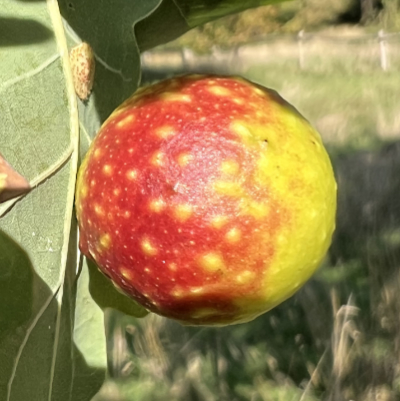
 |
|
Scientific Classifications explained » Amphibians » Ants » Aphids » Bees » Beetles » Birds » Bugs » Butterflies » Caterpillars » Damselflies » Dragonflies » Earwigs » Flies » Frog/Leafhoppers » Fungi » Galls » Grasshoppers » Harvestmen » Hoverflies » Lacewings » Ladybirds » Leaf Mines » Lichens » Mammals » Millipedes » Mosses » Moths » Sawflies » Slugs » Snails » Spiders » Trees & Shrubs » Wasps » Wild Flowers » Woodlice » Postboxes |
UK Nature > Galls > Oak Apple Gall

Gall causer: Biorhiza pallida Common Name: Oak Apple Gall This is one of our most well-known galls. It occurs on both our native oak species, as well as other oak species, and can be found across the UK. It’s caused by the oak apple gall wasp Biorhiza pallida. The wasp lays her eggs inside a dormant leaf bud, which then hatch in spring and start the process for the formation of galls. These galls tend to drop from the trees in June, when the larvae are mature and ready to fly. However, some remain on the tree, going very woody. Inside the gall, there are a number of chambers, each housing a larva which eats its way out. Adults emerge in June and July. The wasp has a second generation: the females that emerge in spring mate and drop to the ground to lay eggs in oak roots, producing further galls. The wingless adults that emerge then climb their way back up the tree, lay eggs, and the whole process starts again. |
|

https://www.uknature.co.uk is a website dedicated to showing the immense diversity of UK nature and wildlife. Our vast range of habitats, from lowland arable to snow covered mountains, from storm-ravaged coastlines to peaceful inland freshwater lakes and rivers, from dry, sandy heaths to deciduous and coniferous forests, all these habitats contribute to the abundance of UK nature. We have wild birds in huge numbers either residing or visiting our shores (597 recorded species as at July 2013) and we must also not forget the humble back garden with its grass lawns, flower beds filled with nectar rich flowers, shrubs and trees, all designed to attract huge numbers of insects such as bees, moths, butterflies and hoverflies; and finally the small ponds which provide safe havens for frogs, toads, newts and even slow worms and grass snakes. www.uknature.co.uk is the showcase for my personal passion, photographing uknature in all its glory. I sincerely hope you all enjoy the fruits of my labours. This site and all images contained therein is © Jeremy Lee 2004 - 2025. All Rights Reserved. Site design by Jeremy Lee. Site development & IT Support by Stuart Lee. |